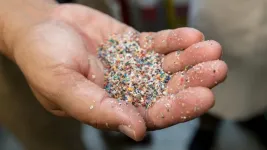(Press-News.org) A new study presents a promising treatment method for so-called fusion-driven cancers, which are currently often difficult to cure. These fusion-driven cancers are caused by an error in cell division that creates a fusion of different genes. This fusion causes the cancer and drives the uncontrolled cell growth.
Using the so-called molecular scissors CRISPR/Cas9, researchers from Aarhus University have developed a gene therapy that can stop cell division in a subtype of the aggressive blood cancer acute myeloid leukaemia (AML).
The study has just been published in the scientific journal Leukemia. Even though the study focuses on blood cancer, many other types of cancer are also driven by fusion genes, for example some lung cancers and sarcomas. The researchers hypothesize that this technology can become a platform technology for specific types of cancer driven by fusion genes.
A paradigm shift in cancer therapy
So far, this gene therapy has been carried out in the laboratory on cell lines and mice. But the results are an important step towards developing a new form of treatment based on targeting the drivers of the disease, explains Associate Professor Maja Ludvigsen from the Department of Clinical Medicine at Aarhus University, who is one of the authors behind the study.
In brief, the researchers have succeeded in cutting genes that, in fusion cancers, are fused incorrectly together and which send a fatal signal to cells to begin dividing uncontrollably. When the fusion gene have been cut, the cancer cells stop dividing.
In this study, the researchers have applied this treatment to cells in a laboratory setting by opening the cell membrane using electricity, a recognised laboratory method that allows substances to pass through the cell membrane. In this way, the ‘scissors’ – the enzyme Cas9 – can target the gene together with guides that consist of RNA (guideRNAs).
"You can use this method in the laboratory, but not in patients. We need to investigate how we can get both scissors and guideRNAs into the cancer cells," says Maja Ludvigsen, who adds that the authors are already working on using fat particles as a delivery method in a parallel study. This method worked very well as a delivery strategy with the mRNA vaccine against Covid 19.
So far, the researchers have inserted cell lines with cancer in the flanks of mice. The non-treated cell lines grew into large tumours, while the treated cells, that had been exposed to the gene therapy before being inserted into the mice, resulted in much smaller tumours or none at all.
"Our gene therapy seems to be extremely effective in the laboratory. We don’t know whether we can make the therapy effective enough to target all the cancer cells. But there is a hypothesis within the field of cancer research that, if you can target the majority of the cancer cells with a treatment, the immune system will take care of the rest," says Maja Ludvigsen.
The next task will be to demonstrate that the treatment with the most optimal delivery method also works in mice that have the specific fusion-driven subtype of leukaemia.
The researchers are also aiming to examine whether this treatment strategy could be a new and better treatment option for other fusion-driven cancers. But there is still some way to go. For example, the researchers do not yet know about the potential side effects of this gene therapy.
"One of the challenges is that if we cut the DNA in a cancer cell where the chromosome is placed incorrectly, then we’ll also be cutting the same chromosome in other healthy cells. Since the fusion gene is not present in healthy cells, our theory is that healthy cells can repair their DNA themselves, but naturally we have to look into this more closely," explains Maja Ludvigsen.
Hope for a more effective treatment
The results created in collaboration between researchers from the Department of Clinical Medicine and the Department of Biomedicine at Aarhus University represent an important step towards understanding and treating fusion-driven cancers.
"This is still in the stage of translational research, but it’s a breakthrough because we’ve succeeded in using the CRISPR/Cas9 technology as target treatment for the specific fusion gene that drives the cancer," says Maja Ludvigsen, who hopes clinical trials with this form of treatment can begin within five years.
"Even though there’s still a lot of work to be done, the results give hope for an effective treatment for patients who have had limited opportunities until now. I hope that, in the future, we’ll be able to introduce a more gentle and more effective treatment without serious side effects," says Maja Ludvigsen.
Facts: What is fusion cancer?
Cancer occurs when cells begin to divide uncontrollably somewhere in the body. One of the reasons for this is the so-called fusion genes.
In fusion cancer, genes fuse together incorrectly during cell division. Moreover, the fusion genes signal to the cells to divide uncontrolled and intensively, thereby driving the disease.
In lung cancer, leukaemia and sarcomas in soft tissues are all examples of cancers with fusion-driven subtypes.
There are also other types of cancer that are not caused by fusion genes, but rather by other genetic abnormalities, including gene mutations.
Behind the research results
The study is translational research – in vitro studies on human cell lines and cells from patients, as well as in vivo in mice.
Partners: Christian Kanstrup Holm (Department of Biomedicine, AU), Yonglun Luo (Department of Biomedicine, AU and Steno Diabetes Center, AUH), Magnus Stougaard (Department of Clinical Medicine – Pathology, AU and AUH, now the Danish Life Science Cluster), Rasmus O. Bak (Department of Biomedicine, AU), Marie Bill (Department of Haematology, AUH), Peter Hokland (formerly the Department of Clinical Medicine – Haematology, AU and AUH), Mette Nyegaard (formerly Department of Biomedicine, AU, now Department of Health Science and Technology, AAU) and Boe Sorensen (Department of Clinical Medicine – Department of Clinical Biochemistry, AU and AUH)
External funding: AUFF NOVA (Aarhus University), Karen Elise Jensen’s Foundation, the Danish Cancer Society and the Central Denmark Region’s Health Science Research Foundation
: Dual intron-targeted CRISPR-Cas9-mediated disruption of the AML RUNX1-RUNX1T1 fusion gene effectively inhibits proliferation and decreases tumor volume in vitro and in vivo | Leukemia (nature.com)
Contact
Associate Professor Maja Ludvigsen
Aarhus University, Department of Clinical Medicine and Aarhus University Hospital, Department of Haematology
Mobile: 22 85 95 23
Mail: majlud@clin.au.dk
END
Research raises hopes for new treatment of fusion-driven cancer
A new form of gene therapy can stop cell division in a particularly aggressive type of cancer
2023-08-11
ELSE PRESS RELEASES FROM THIS DATE:
Direct evidence for modified gravity at low acceleration from Gaia observations of wide binary stars
2023-08-11
A new study reports conclusive evidence for the breakdown of standard gravity in the low acceleration limit from a verifiable analysis of the orbital motions of long-period, widely separated, binary stars, usually referred to as wide binaries in astronomy and astrophysics. The study carried out by Kyu-Hyun Chae, professor of physics and astronomy at Sejong University in Seoul, used up to 26,500 wide binaries within 650 light years (LY) observed by European Space Agency’s Gaia space telescope. Kareem El-Badry, then at Harvard and now a faculty at ...
Social media use interventions alleviate symptoms of depression
2023-08-11
Receiving therapy for problematic social media use can be effective in improving the mental wellbeing of people with depression, finds a new study by UCL researchers.
The research, published in the Journal of Medical Internet Research, found that social media use interventions could help adults for whom social media use has become problematic or interferes with their mental health.
Problematic use is when a person’s pre-occupation with social media results in a distraction from their primary tasks and the neglect of responsibilities in other aspects of their life.
Previous research* has suggested that social media use can become problematic ...
Hidden moles in hidden holes
2023-08-11
Scientists have identified two types of mole which they believe have been living undiscovered in the mountains of eastern Turkey for as many as 3 million years.
The new moles – named Talpa hakkariensis and Talpa davidiana tatvanensis – belong to a familiar group of subterranean, invertebrate-eating mammals found across Europe and Western Asia.
While only one species, Talpa europaea, is found in Britain, further east there are a number of different moles, many of which have very small geographical ranges.
The researchers – using cutting edge DNA technology – ...
Soil microbiome, Earth’s ‘living skin’ under threat from climate change
2023-08-11
UNIVERSITY PARK, Pa. — Using a novel method to detect microbial activity in biological soil crusts, or biocrusts, after they are wetted, a Penn State-led research team in a new study uncovered clues that will lead to a better understanding of the role microbes play in forming a living skin over many semi-arid ecosystems around the world. The tiny organisms — and the microbiomes they create — are threatened by climate change.
The researchers published their findings in Frontiers of Microbiology.
“Biocrusts ...
Zentropy and the art of creating new ferroelectric materials
2023-08-11
UNIVERSITY PARK, Pa. — Systems in the Universe trend toward disorder, with only applied energy keeping the chaos at bay. The concept is called entropy, and examples can be found everywhere: ice melting, campfire burning, water boiling. Zentropy theory, however, adds another level to the mix.
A team led by Zi-Kui Liu, the Dorothy Pate Enright Professor of Materials Science and Engineering at Penn State, developed the theory. The “Z” in zentropy stands for the German word Zustandssumm, meaning ‘‘sum over states” of entropy. Alternatively, Liu said, zentropy may be considered as a play on the term “zen” ...
Ribbons of graphene push the material’s potential
2023-08-11
Think you know everything about a material? Try giving it a twist—literally. That’s the main idea of an emerging field in condensed matter physics called “twistronics,” which has researchers drastically changing the properties of 2D materials, like graphene, with subtle changes—as small as going from a 1.1° to 1.2°—in the angle between stacked layers. Twisted layers of graphene, for example, have been shown to behave in ways that single sheets have not, including acting like magnets, like electrical superconductors, or like a superconductor’s opposite, insulators, all due to small changes in the twist angle between sheets.
In theory, you ...
New recycling process could find markets for ‘junk’ plastic waste
2023-08-11
MADISON – Although many Americans dutifully deposit their plastic trash into the appropriate bins each week, many of those materials, including flexible films, multilayer materials and a lot of colored plastics, are not recyclable using conventional mechanical recycling methods. In the end, only about 9 percent of plastic in the United States is ever reused, often in low-value products. With a new technique, however, University of Wisconsin–Madison chemical engineers are turning low-value waste plastic into high-value ...
The Israeli Override Clause: a threat to the health in all policies approach
2023-08-11
On July 24, 2023, Israel's Parliament sanctioned a substantial amendment to the Basic Law, prompting apprehensions regarding power equilibrium and its potential influence on public well-being. In response, a coalition of prominent Israeli and global public health experts has united to dissect the profound ramifications of this revision in an article titled “Israel's Judicial Overhaul: A Threat to the Health in All Policies Approach” featured in The Lancet.
The amendment, restricts ...
Indicator of PFAS found in some — but not all — period products
2023-08-11
SAN FRANCISCO, Aug. 10, 2023 — Period products come in a variety of styles — liners, pads, tampons, cups and underwear — to help people feel comfortable during a menstrual bleed. But their labels don’t usually list the ingredients, so consumers don’t know what’s in their product of choice. Now, researchers have analyzed over 100 period products for fluorinated compounds, an indicator of potentially harmful per- and polyfluoroalkyl substances, or PFAS. Their results show that while PFAS are absent from many products, ...
Exercise training and yoga can help improve lung function in adults with asthma
2023-08-11
Yoga and breathing control practices, in combination with aerobic training, are particularly key exercises for asthmatic people seeking to improve their lung function, a new peer-reviewed study suggests.
The research which is published today in the journal Annals of Medicine highlights the importance of integrating appropriate exercise training into asthma management plans.
The findings demonstrate just how effective specific types of exercise training can be to enhance lung function for those with adults, explains ...
LAST 30 PRESS RELEASES:
Why nail-biting, procrastination and other self-sabotaging behaviors are rooted in survival instincts
Regional variations in mechanical properties of porcine leptomeninges
Artificial empathy in therapy and healthcare: advancements in interpersonal interaction technologies
Why some brains switch gears more efficiently than others
UVA’s Jundong Li wins ICDM’S 2025 Tao Li Award for data mining, machine learning
UVA’s low-power, high-performance computer power player Mircea Stan earns National Academy of Inventors fellowship
Not playing by the rules: USU researcher explores filamentous algae dynamics in rivers
Do our body clocks influence our risk of dementia?
Anthropologists offer new evidence of bipedalism in long-debated fossil discovery
Safer receipt paper from wood
Dosage-sensitive genes suggest no whole-genome duplications in ancestral angiosperm
First ancient human herpesvirus genomes document their deep history with humans
Why Some Bacteria Survive Antibiotics and How to Stop Them - New study reveals that bacteria can survive antibiotic treatment through two fundamentally different “shutdown modes”
UCLA study links scar healing to dangerous placenta condition
CHANGE-seq-BE finds off-target changes in the genome from base editors
The Journal of Nuclear Medicine Ahead-of-Print Tip Sheet: January 2, 2026
Delayed or absent first dose of measles, mumps, and rubella vaccination
Trends in US preterm birth rates by household income and race and ethnicity
Study identifies potential biomarker linked to progression and brain inflammation in multiple sclerosis
Many mothers in Norway do not show up for postnatal check-ups
Researchers want to find out why quick clay is so unstable
Superradiant spins show teamwork at the quantum scale
Cleveland Clinic Research links tumor bacteria to immunotherapy resistance in head and neck cancer
First Editorial of 2026: Resisting AI slop
Joint ground- and space-based observations reveal Saturn-mass rogue planet
Inheritable genetic variant offers protection against blood cancer risk and progression
Pigs settled Pacific islands alongside early human voyagers
A Coral reef’s daily pulse reshapes microbes in surrounding waters
EAST Tokamak experiments exceed plasma density limit, offering new approach to fusion ignition
Groundbreaking discovery reveals Africa’s oldest cremation pyre and complex ritual practices
[Press-News.org] Research raises hopes for new treatment of fusion-driven cancerA new form of gene therapy can stop cell division in a particularly aggressive type of cancer





